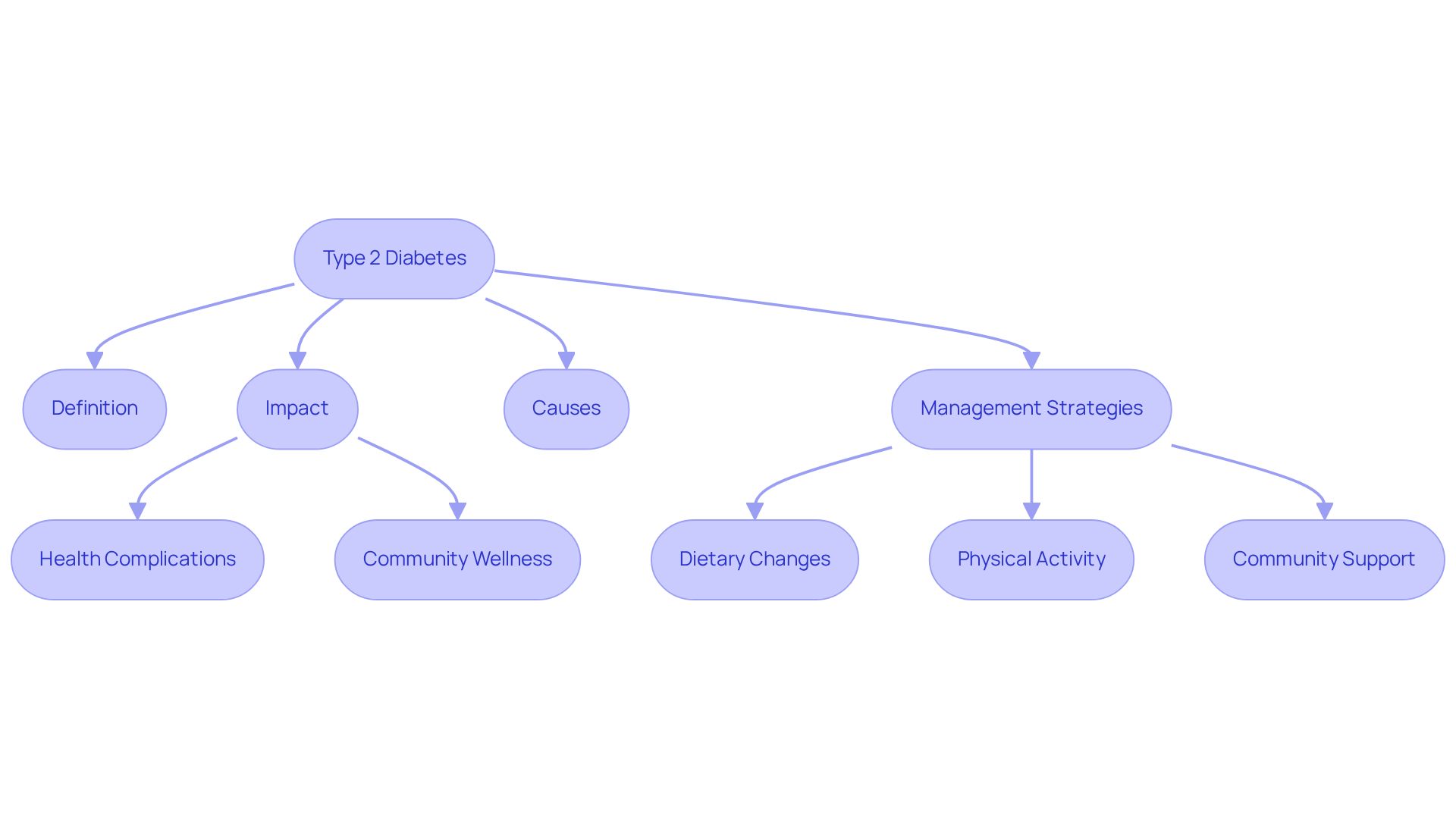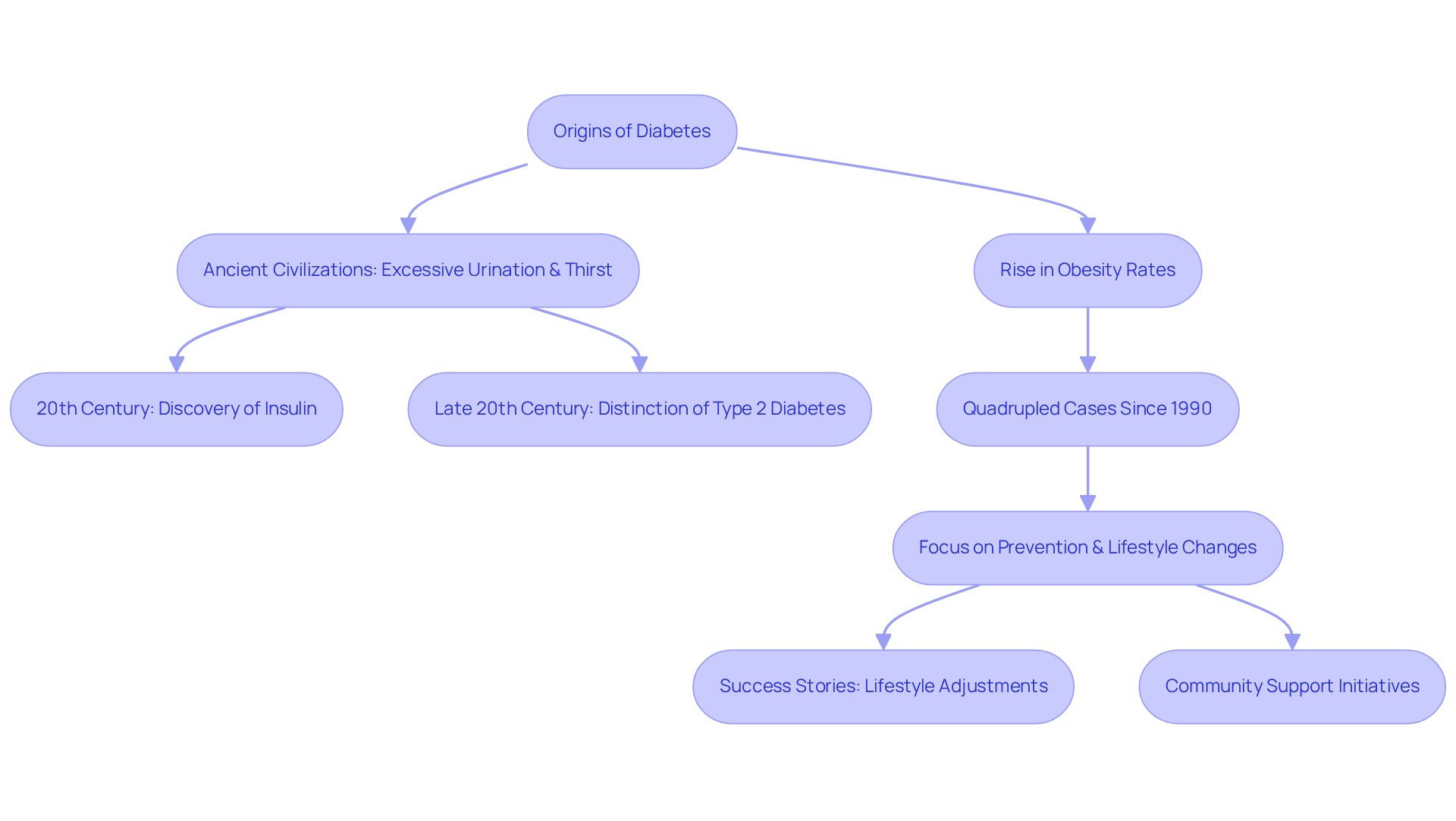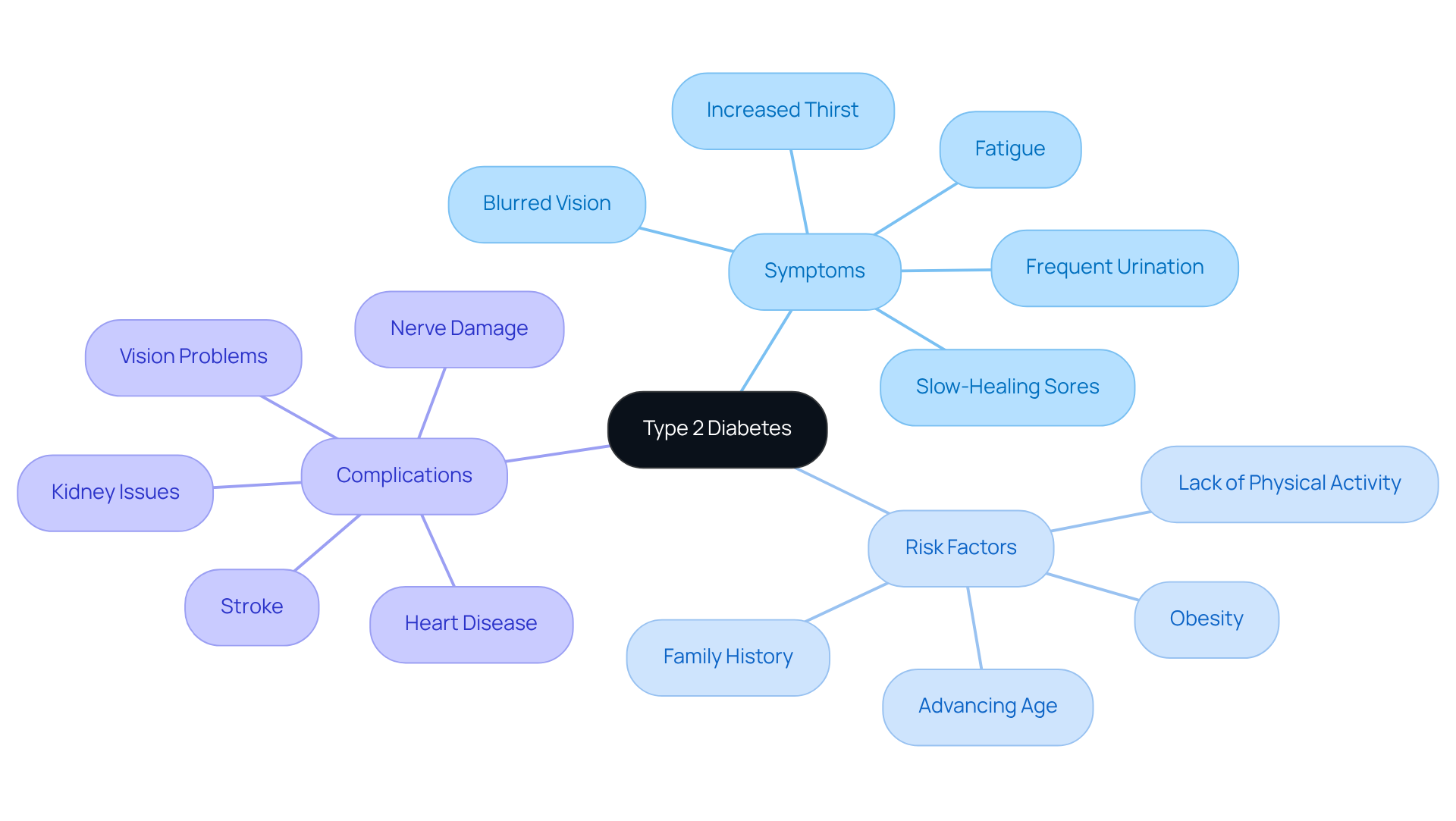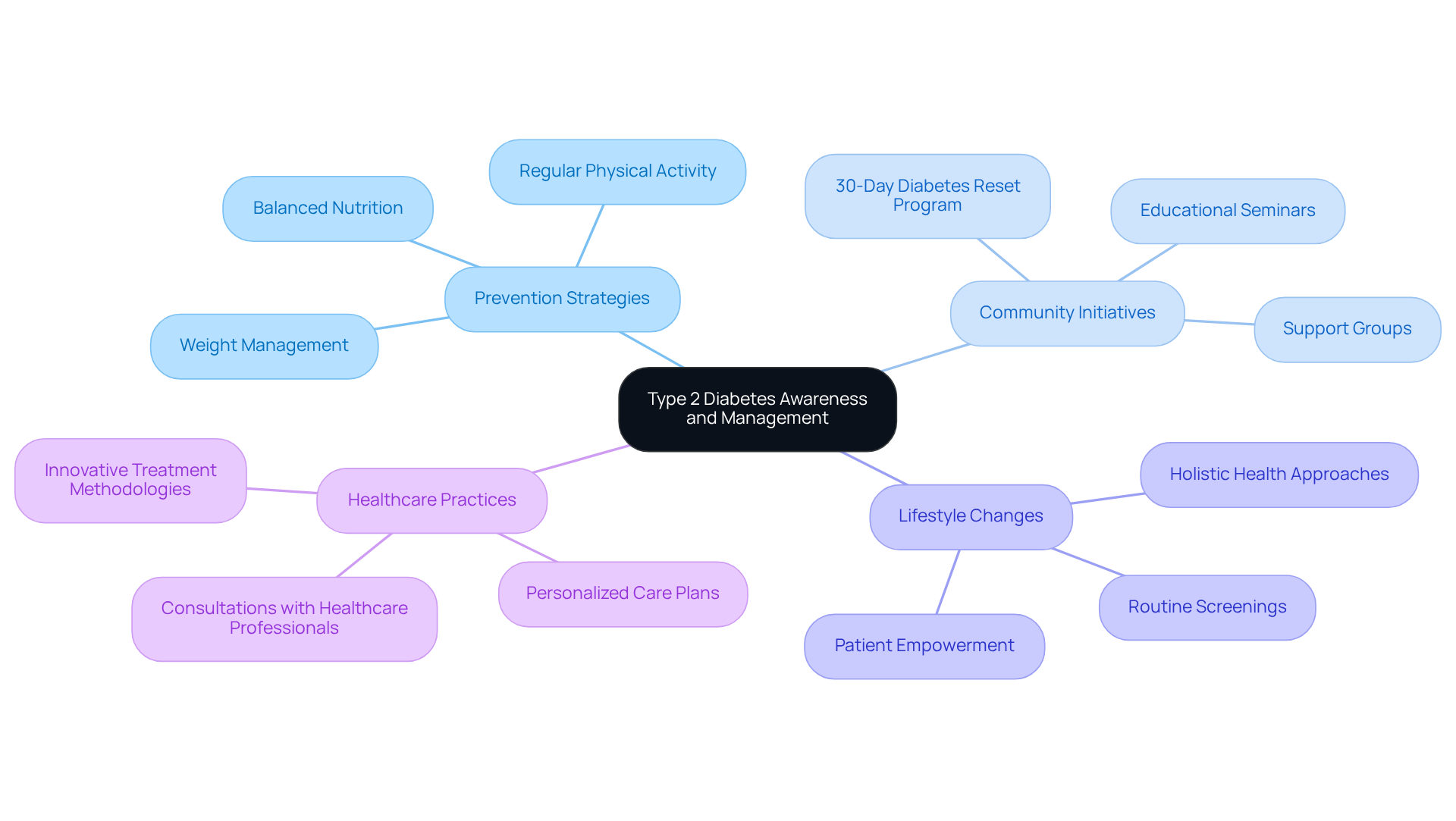Overview
Type 2 diabetes is a chronic metabolic condition that many people face, characterized by insulin resistance and a relative deficiency in insulin secretion. This leads to elevated blood glucose levels and potential serious complications. It’s important to recognize that lifestyle factors, such as obesity and sedentary behavior, significantly contribute to this condition. By acknowledging these challenges, we can better understand the importance of early detection, community support, and lifestyle modifications in managing and preventing its onset.
Many patients find that making small changes can lead to significant improvements in their health. This journey toward better health is not just about managing diabetes; it’s about embracing a healthier lifestyle. Imagine feeling more energized and vibrant as you take steps toward a more active life. The 30-Day Diabetes Reset program offers a supportive framework to help you on this path.
Remember, you are not alone in this journey. Community support can make a world of difference. Sharing experiences and tips with others can provide the encouragement you need. Together, we can create a nurturing environment that fosters healthy habits and positive change. Let’s take this step forward together.
Introduction
Type 2 diabetes has emerged as a significant public health concern, impacting millions around the world and changing how we think about health and wellness. This chronic condition, marked by insulin resistance and high blood sugar levels, is often tied to lifestyle choices. It’s important to recognize that understanding its implications and management strategies is crucial for individuals navigating this journey. With projections indicating a concerning rise in cases, many may wonder: how can communities and individuals work together to combat this growing epidemic and reclaim their health?
It’s essential to acknowledge the struggles that come with this condition. Many patients find that the emotional weight of managing diabetes can feel overwhelming. By fostering a supportive environment and sharing effective management strategies, we can empower ourselves and each other. Let’s explore how we can take steps toward healthier living, together.
Define Type 2 Diabetes: Understanding the Condition and Its Impact
What is type 2 diabetes definition? It is a chronic metabolic condition that can feel overwhelming, characterized by insulin resistance and a relative deficiency in insulin secretion. Unlike type 1 diabetes, where the pancreas fails to produce insulin, individuals with type 2 diabetes can produce insulin, yet their bodies struggle to utilize it effectively. This dysfunction can lead to elevated blood glucose levels, which, if not managed properly, may result in serious complications. It’s important to recognize that this condition is often linked to obesity, sedentary lifestyles, and poor dietary habits, making it a significant public health challenge that affects many lives.
In San Marcos, CA, there is hope in managing type 2 diabetes through holistic lifestyle changes that embrace the beautiful local environment. Regular outdoor activities, such as hiking at Lake San Marcos or walking the trails at Discovery Lake, not only provide essential exercise but also enhance mood and help regulate blood sugar levels. A balanced diet rich in local produce, including avocados and berries, is vital for maintaining healthy blood sugar levels. Many patients find that participating in community wellness initiatives offers valuable assistance and resources tailored to effectively managing their blood sugar levels.
Globally, around 589 million adults aged 20-79 are currently living with this condition, representing a staggering 10.5% of the world’s population. Projections indicate that this number could rise to 783 million by 2045, underscoring the urgent need for effective management strategies. In the United States alone, this condition accounted for roughly 103,000 fatalities in 2021, ranking as the eighth leading cause of death in the nation. This reality can be daunting, but understanding that support is available can make a significant difference.
Understanding what is type 2 diabetes definition is essential, as insulin resistance plays a key role in its onset. Insulin resistance, as described in what is type 2 diabetes definition, occurs when the body’s cells become less responsive to insulin, leading to increased blood sugar levels. This condition can be managed through lifestyle modifications such as weight management, regular physical activity, and dietary changes. Practical illustrations show that individuals who embrace these approaches can greatly lower their chances of developing this chronic condition and its related complications. Remember, every small step counts.
Health professionals emphasize the importance of early detection and intervention in managing insulin resistance. By tackling the root factors, such as obesity and inactivity, healthcare providers can assist patients in reclaiming control over their well-being. The impact of type 2 diabetes on community wellness is significant, with growing prevalence rates leading to higher healthcare expenses and a larger strain on medical systems. As the worldwide population affected by this condition continues to increase, it is essential to focus on education, prevention, and efficient management strategies to lessen the impact on individuals and society.
Furthermore, during heat waves, individuals with insulin resistance should remain hydrated, check blood sugar levels regularly, and seek advice from healthcare professionals regarding medication modifications to ensure safety and health management. It’s crucial to prioritize your health and well-being, and remember, you are not alone in this journey.
Trace the Origins of Type 2 Diabetes: Historical Context and Evolution
The roots of diabetes can be traced back to ancient civilizations, where it was recognized as a disorder marked by excessive urination and thirst. The term ‘diabetes’ comes from the Greek word ‘siphon,’ aptly describing the frequent urination experienced by patients. It’s important to recognize that while our understanding of diabetes began to progress notably in the early 20th century with the discovery of insulin, it wasn’t until the late 20th century that we started to understand what is type 2 diabetes definition as a distinct condition, primarily linked to lifestyle factors such as nutrition and exercise.
In recent decades, many have noticed the alarming rise in obesity rates closely linked with what is type 2 diabetes definition. For instance, global cases of the disease have quadrupled since 1990, with over 800 million adults currently living with this condition. This increase has led to a vital shift in focus toward prevention and lifestyle adjustments as crucial methods for managing diabetes. Many patients find that maintaining a healthy body weight, engaging in regular physical activity, and following a balanced diet are essential in understanding what is type 2 diabetes definition and in lowering the risk of developing this condition.
As our understanding of diabetes evolves, particularly regarding what is type 2 diabetes definition, it is clear that addressing lifestyle factors is crucial in combating this growing epidemic. The combination of educational materials and community support, as demonstrated by initiatives like Dr. Jason Shumard’s 30-Day Diabetes Reset, empowers individuals to take charge of their health and understand what is type 2 diabetes definition to reduce the associated risks. For example, one patient shared their inspiring journey of losing 55 lbs and reducing their A1C from 9.1 to 5.7 after participating in the program. Dr. Shumard’s expertise in functional medicine, paired with the support available at the Integrative Wellness Center, offers a transformative approach to reversing insulin resistance and promoting holistic health and well-being.
Examine Key Characteristics of Type 2 Diabetes: Symptoms, Risk Factors, and Complications
According to what is type 2 diabetes definition, type 2 diabetes mellitus presents a range of symptoms that can be quite concerning, including:
- Increased thirst
- Frequent urination
- Fatigue
- Blurred vision
- Slow-healing sores
It’s important to recognize that these symptoms often serve as critical warning signs that should not be overlooked. The multifaceted risk factors for developing this condition, as outlined in what is type 2 diabetes definition, include:
- Obesity
- Lack of physical activity
- Family history
- Advancing age
In today’s world, lifestyle choices—such as poor diet and sedentary habits—significantly contribute to the rising prevalence of what is type 2 diabetes definition. For instance, approximately 47.1% of U.S. adults with diagnosed blood sugar issues are categorized as obese, underscoring the connection between weight and the risk of such conditions.
The severe and life-altering complications stem from what is type 2 diabetes definition. They may include:
- Heart disease
- Stroke
- Nerve damage
- Kidney issues
- Vision problems
The condition is the leading cause of new cases of blindness among adults aged 20 to 74 years. The American Diabetes Association reports that type 2 diabetes definition encompasses a condition that contributes to over 79,000 deaths each year, highlighting the critical need for effective management and early intervention strategies. Many patients find that by understanding these traits, they can more effectively identify possible warning signals and seek prompt medical advice, which can greatly alter the progression of the illness.
If you or someone you know is struggling with these symptoms, remember that you are not alone. There are supportive resources available, such as the 30-Day Diabetes Reset program, which can guide you toward healthier choices and better management of your health.
Highlight the Importance of Type 2 Diabetes Awareness: Prevention and Management Strategies
It is essential to understand what is type 2 diabetes definition for both prevention and effective management. It’s important to recognize that education on healthy lifestyle choices, such as balanced nutrition and regular physical activity, can significantly lower the risk of developing this condition. Many patients find that lifestyle changes can avert or postpone the emergence of type 2 diabetes, which relates to what is type 2 diabetes definition, with research showing that consistent exercise and weight control are essential elements in lowering disease risk.
Community initiatives, such as Dr. Jason Shumard’s comprehensive 30-Day Diabetes Reset program, empower individuals by providing them with essential knowledge and practical tools for managing diabetes effectively. This program is designed to help participants stabilize their glucose levels without the dependency on insulin and prescription drugs, ultimately leading to renewed energy and reduced anxiety about potential complications. Dr. Shumard emphasizes, “What distinguishes the Integrative Wellness Center is its holistic approach to well-being, concentrating on personalized care and education rather than merely symptom management.”
Routine screenings and consultations with healthcare professionals are crucial for early detection of at-risk persons, allowing prompt interventions that can stop disease progression. Testimonials from past participants highlight the transformative impact of the program, showcasing real-life success stories. By cultivating a setting of learning and assistance, these strategies not only improve individual wellness results but also aid in a larger public initiative against the diabetes epidemic.
If you’re ready to take control of your health, contact the Integrative Wellness Center today to learn more about how you can join the 30-Day Diabetes Reset program. You deserve the support and guidance to embark on this journey toward better health.
Conclusion
Type 2 diabetes is a complex condition that requires a comprehensive understanding of its mechanisms, symptoms, and management strategies. It’s important to recognize that this chronic metabolic disorder significantly impacts millions of lives globally. By embracing lifestyle changes and utilizing available resources, individuals can take proactive steps to manage their health effectively.
Many patients find that early detection is crucial. Key insights highlight the role of insulin resistance and the profound effects of lifestyle choices on the onset and progression of type 2 diabetes. Community support initiatives, such as the 30-Day Diabetes Reset program, demonstrate the transformative potential of education and personalized care in managing this condition. Additionally, the alarming statistics surrounding the prevalence and complications of type 2 diabetes underscore the urgent need for awareness and preventive measures.
As the global burden of type 2 diabetes continues to rise, it becomes increasingly vital for individuals and communities to prioritize health education and lifestyle modifications. Engaging with healthcare professionals and participating in supportive programs can empower those at risk to reclaim their well-being. The journey toward better health begins with a single step—take that step today and explore the resources available to combat this growing epidemic.
Frequently Asked Questions
What is the definition of type 2 diabetes?
Type 2 diabetes is a chronic metabolic condition characterized by insulin resistance and a relative deficiency in insulin secretion, leading to elevated blood glucose levels.
How does type 2 diabetes differ from type 1 diabetes?
Unlike type 1 diabetes, where the pancreas fails to produce insulin, individuals with type 2 diabetes can produce insulin but struggle to utilize it effectively.
What are the common causes associated with type 2 diabetes?
Type 2 diabetes is often linked to obesity, sedentary lifestyles, and poor dietary habits.
How can lifestyle changes help manage type 2 diabetes?
Holistic lifestyle changes, such as regular outdoor activities and a balanced diet rich in local produce, can help regulate blood sugar levels and improve overall health.
How prevalent is type 2 diabetes globally?
Approximately 589 million adults aged 20-79 are living with type 2 diabetes, representing about 10.5% of the world’s population, with projections indicating this could rise to 783 million by 2045.
What impact does type 2 diabetes have in the United States?
In 2021, type 2 diabetes accounted for roughly 103,000 fatalities in the U.S., making it the eighth leading cause of death in the nation.
What role does insulin resistance play in type 2 diabetes?
Insulin resistance occurs when the body’s cells become less responsive to insulin, leading to increased blood sugar levels, which is a key factor in the onset of type 2 diabetes.
What strategies can help prevent type 2 diabetes?
Weight management, regular physical activity, and dietary changes are effective strategies for lowering the chances of developing type 2 diabetes and its related complications.
Why is early detection important in managing type 2 diabetes?
Early detection and intervention can help tackle root factors such as obesity and inactivity, enabling healthcare providers to assist patients in reclaiming control over their well-being.
What should individuals with insulin resistance do during heat waves?
Individuals should remain hydrated, check blood sugar levels regularly, and consult healthcare professionals regarding medication modifications to ensure safety and health management.



